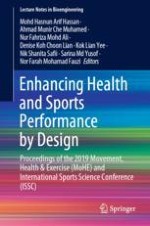2020 | OriginalPaper | Buchkapitel
The Effects of High Intensity Functional Interval Training on Selected Fitness Components Among Young Badminton Players
verfasst von : Pathmanathan K. Suppiah, Angelica Joanne Joummy, Md. Safwan Samsir, Muralindran Mariappan, Hasnol Noordin, Abdul Mu’iz Bin Nor Azmi
Erschienen in: Enhancing Health and Sports Performance by Design
Verlag: Springer Singapore
Aktivieren Sie unsere intelligente Suche, um passende Fachinhalte oder Patente zu finden.
Wählen Sie Textabschnitte aus um mit Künstlicher Intelligenz passenden Patente zu finden. powered by
Markieren Sie Textabschnitte, um KI-gestützt weitere passende Inhalte zu finden. powered by
